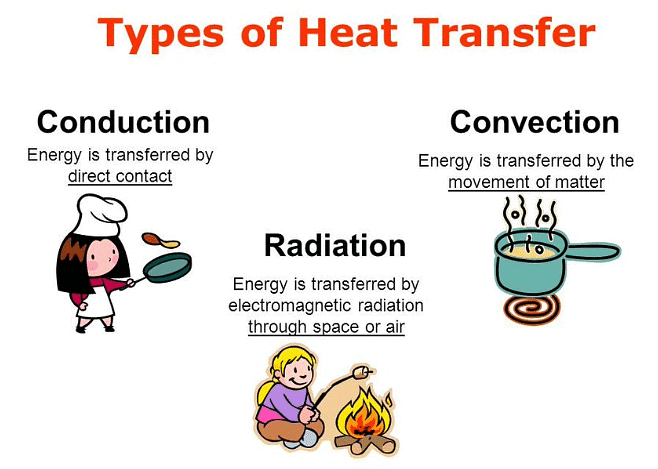Class 9 Exam > Class 9 Notes > Year 9 Physics (Cambridge) > Energy
Energy | Year 9 Physics (Cambridge) - Class 9 PDF Download
| Table of contents |

|
| Introduction to Energy Conservation |

|
| Methods of Energy Conservation |

|
| Types of Heat Transfer |

|
| Understanding Convection Currents |

|
Introduction to Energy Conservation
- Purpose: Energy conservation aims to minimize energy wastage and optimize efficiency in everyday activities.
- Importance: Helps in reducing environmental impact and promoting sustainable practices.

Methods of Energy Conservation
- Reducing Energy Wastage: Examples include turning off lights when not in use and unplugging electronics.
- Improving Efficiency: Using energy-efficient appliances and insulating buildings.
Question for EnergyTry yourself: Which of the following is an example of reducing energy wastage?View Solution
Types of Heat Transfer
- Conduction
- Definition: Transfer of heat through direct contact.
- Example: Heating a metal spoon by placing it in hot soup.
- Convection
- Definition: Transfer of heat through the movement of fluids (liquids or gases).
- Example: Heating a room with a radiator where hot air rises and cool air sinks.
- Radiation
- Definition: Transfer of heat through electromagnetic waves.
- Example: Feeling warmth from the sun on a sunny day.
- Role of Insulation in Energy Conservation
- Definition: Insulation reduces heat loss by providing a barrier against external temperature changes.
- Examples: Using materials like fiberglass or foam to insulate walls, roofs, and pipes.
- Evaporation and Cooling
- Process: Evaporation absorbs heat from the surroundings, thereby cooling the environment.
- Example: Sweating cools the body by evaporation of sweat from the skin.

Understanding Convection Currents
Atmospheric Circulation
- Process: Warm air rises while cooler air sinks, creating convection currents in the atmosphere.
- Example: Sea breezes and land breezes are caused by convection currents near coastlines.
Applications of Energy Transfer Principles
- Environmental Impact: Understanding energy transfer helps in reducing carbon footprint and environmental degradation.
- Sustainable Practices: Promotes efficient use of resources and renewable energy sources.
Conclusion
Understanding energy conservation and heat transfer principles is crucial for minimizing energy use, reducing environmental impact, and promoting sustainable living practices.
Question for EnergyTry yourself: Which type of heat transfer involves the movement of fluids like liquids or gases?View Solution
The document Energy | Year 9 Physics (Cambridge) - Class 9 is a part of the Class 9 Course Year 9 Physics (Cambridge).
All you need of Class 9 at this link: Class 9
|
9 videos|20 docs|4 tests
|
FAQs on Energy - Year 9 Physics (Cambridge) - Class 9
| 1. How can schools benefit from implementing energy efficiency measures? |  |
Ans. Schools can benefit from implementing energy efficiency measures by reducing energy costs, improving the learning environment for students, and reducing their carbon footprint. Additionally, energy efficiency measures can help schools comply with regulations and demonstrate their commitment to sustainability.
| 2. What are some common energy-saving strategies that schools can implement? |  |
Ans. Some common energy-saving strategies that schools can implement include upgrading to energy-efficient lighting, installing programmable thermostats, conducting regular maintenance on HVAC systems, and educating staff and students on energy conservation practices.
| 3. How can schools track their energy usage and identify opportunities for improvement? |  |
Ans. Schools can track their energy usage by monitoring utility bills, conducting energy audits, and using energy management software. By analyzing this data, schools can identify areas where energy efficiency can be improved and develop a plan to implement changes.
| 4. Are there any government incentives available to help schools finance energy efficiency projects? |  |
Ans. Yes, there are government incentives available to help schools finance energy efficiency projects. These incentives may include grants, rebates, and financing programs that can help offset the upfront costs of implementing energy-saving measures.
| 5. How can schools engage students and staff in energy conservation efforts? |  |
Ans. Schools can engage students and staff in energy conservation efforts by organizing educational campaigns, implementing energy-saving competitions, and involving students in energy efficiency projects. By fostering a culture of energy conservation, schools can create lasting behavior change and reduce their overall energy consumption.
Related Searches















